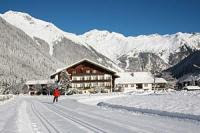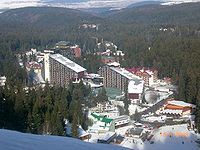SOFIA - CAPITAL OF BULGARIA
Bulgaria is a wonderful country and the
people are still changing over from communism to democracy. Bulgaria lies in
the east of the Balkan Peninsular. More than half of the country is mountainous
or have hills. Right through the centre of Bulgaria runs the Balkan Mountains
and in the south-west are the Rhodope Mountains. The Rhodope Mountains have the
highest peak -- Musala Peak with 2923m.
In the Thrace and Maritsa valleys are
the southern lowlands. The River Danube flows through the northern part of the
country. About 30% of the country is covered with forests of conifers, beeches
and oaks. Wildlife of bears, wolves, elks, foxes and wildcats are mainly found
in the mountains of the south west.
The climate in the central valley and
lowlands is warm summers and snowy winters. The climate along the
Black Sea is warmer.
RHODOPE MOUNTAINS
 |
| RHODOPE MOUNTAINS -- TRIGRAD GORGE |
RHODOPE MOUNTAINS -- TRIGRAD GORGE
Bulgaria borders, in the north on
Romania. In the south it borders on Greece and Turkey. In the west it borders on
Yugoslavia and Macedonia. In the east it has a long coastline along the
Black Sea.
The population consists of 85%
Bulgarian, a minority of Turks, Macedonians, Romanise, Armenians and Russians.
The main religion is Bulgarian Orthodox Christianity but also Islam is
practiced by a minority.
Areas mostly populated are Sofia,
Plovdiv and along the Danube plain.
Health service and education are free
to all. However, there is a shortage in both services. The education moves
slowly from the Soviet style to the Western style.
Bulgaria produces machineries,
chemicals and electronics. The most famous export is the fragrant attar (oil)
of the roses made from damask roses. For further information please visit my
article The Valley of Roses.
.

THE GOLDEN RHYTON
ONE OF THE ITEMS IN
THE THRACIAN
PANAGYURISHTE
TREASURES
4TH TO 3RD BC
ONE OF THE ITEMS IN
THE THRACIAN
PANAGYURISHTE
TREASURES
4TH TO 3RD BC

IVAN SHISHMAN THE LAST RULER OF THE TARNOVO TSARDOM 1371-1395
HISTORY
Prehistoric culture was the Neolithic
HAMAGIA and VINCA from 6th to 3rd century BC. The Varna culture lived in the 5th
century BC and in the Bronze Age EZARO.
The Thracian was various tribes and
King Teres united them in 500 BC and called it IDRYSIA kingdom. They were
conquered by Alexander the Great and then by the Romans. They migrated and
settled in the eastern most SouthSlavs settlement which is Bulgaria today. They
lived with the Hellenised or Romanised Thracian. The Bulgar elite established
The First Bulgarian Empire.
Asparukh, heir of Old Great Bulgaria's
Khan Kubrat migrated with several Bulgar tribes to the lower Danube after his
father's state was conquered. Asparukh conquered Moesia and Soythia Minor from
the Byzantinian Empire. He signed a peace treaty with the Byzantine in 681 and
made Pliska the capital of Bulgaria.
700/701 - 718/721 Tervel made the
borders safe and Bulgaria a powerful nation when he defeated 22,0000 Arab
Armies in 717; stopping an Arab invasion into Eastern Europe and Central
Europe.
802-814, Krum established a country twice
the size and killed Nicephorush I in the battle of Pliska. He wrote the code of
law for both the Slavs and Bulgars.
852-889, Boris I the Baptist
abolished Tengriism and introduced Eastern Orthodox Christianity as well as the
Cyrillic alphabet.
893-927, Emperor Simeon I the Great
ruled and establish Bulgaria with a great expansion. He had a military
supremacy over the Byzantine Empire.
927 the Battle of Andualos were one
of the bloodiest battle in the Middle Ages and one of his decisive victories.
Under his reign Bulgaria became a rich culture
After his death Bulgaria declined
because of various wars. It resulted to the invasion of the RUS in 969-971 and
Byzantine captured the capital Preslav.
Under Sumuil rule, Bulgaria conquered
Serbia and Bosnia.
1014, Byzantine Emperor Basil II
defeated the army at Klyuch. Sumuil died soon after and by 1018 Bulgaria was
fully ruled by the Byzantine Empire.
After Basil II death the politics
changed and it led to several rebellions.
1185, Asen I and Peter IV succeeded
after a major uprising and re-established the Bulgarian state and with that
began the second Bulgarian Empire. The Asen dynasty declared Veliko Tarnovo,
Kaloyan the capital of Bulgaria.
1218-1241, Ivan Asen II conquered
Albania, Epirus, Macedonia and Thrace. He established the Tarnovo Artistic
School and minted coins.
Due to the Tatar invasion the Asen
dynasty ended in 1257.
By the end of 14th century the empire
split up into small tsardoms and principalities. Then they fought amongst
themselves.
Between 1365-1370 the Ottoman Turks
started to and conquered Bulgaria
1877-78 In the Russo-Turk War the
Russian army defeated the Ottoman forces.
From 1912 to 1913 Bulgaria became
involved in the Balkan Wars.
In the WW I Bulgaria sided with the
German and became defeated and lost a lot of territories.
During 1920 - 1930 the country had a
lot of political unrest. It led to a Royal authoritarian dictatorship Tsar
Boris III from 1918-1943.
In the WW II Bulgaria joint the Axis
but refused to take part in the Operation Barbarossa. It did not declare war on
the USSR. It saved its Jewish population by postponing transportation, times
and times again.
1943 Boris III died suddenly and the
country went into a turmoil. Germany lost the war and the Russian rolled into
Bulgaria. It became a communist country.
1990, Bulgaria had its first free
election. 2007 it joined the NATO and in 2007 the EU.

ROMAN SITE IN PLODIV -- PLODIV IS EUROPE'S OLDEST CITY AND THE 6TH IN
THE WORLD -- SETTLEMENTS SINCE 3000 BC.
Bulgaria is privatising only slowly and is the slowest in Eastern Europe. It suffers from an industrial output decline and high inflation. Their trading partner is EU, Russia and Ukraine.
Agriculture is their most important
economic sector. Their problems are under-mechanized, and hampered by the slow
transfer of farms from state to private ownership. However, their fertile land
makes up for that and their crops include cereals, vines (Bulgaria exports a
lot of vines) cotton, tobacco and fruit. Forestry is one of the big industries
and they cut over four million cubic metres annually. Fishing is another big
industry. 27,000 tonnes caught annually, mainly Mackerel.
Bulgaria is a parliamentary republic.
It has a multi-party politics. Parliament has a 240 member National Assembly
and is elected every five year by proportional representatives. The leader of
the Assembly’s majority party becomes prime minister. The president is the head
of state and commander-in-chief of the armed forces. He is elected every five
year by popular.
In the 20th century, its literature
is still important. Elias Nanette won the 1981 Nobel Prize for literature Music
and folk art are thriving activities.
HOLIDAY
Bulgaria has a beautiful countryside
with its coastline along the Black Sea, its mountain with famous ski resorts of
Vitosha near Sofia, the capital, the Rila mountains mountains, Rhodope Mountains
and the Balkan Mountains all offer great ski resorts such as Pamporovo,
Cheaplare, Borovet and Bansko. Summer holidays are ideal on the Sunny Beaches
and Golden Sand with the cities of Nessebur and Varna to visit from there. The
Valley of Kazanlak is not only famous for its rose growing but it offers a
beautiful countryside, for walking, camping, biking, fishing, mountain climbing
and with tremendous wildlife for a great nature watch. For the size of the
country it has so much to offer you will be spoiled for choices. The food, wine
and beer is excellent
Great value for money, the prices are
still low because tourism hasn't built up yet.
ONE PROBLEM WITH
BULGARIA YOU WILL FIND IS THAT WHEN YOU SHAKE YOUR HEAD IT MEANS -- YES -- AND
WHEN YOU NOD YOUR HEAD IT MEANS -- NO --.
PIRIN MOUNTAINS -- IT HOLDS ONE OF THE WOLRD'S OLDEST TREES --
BAIKUSHEV'S PINE




















